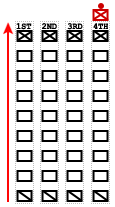Oblique order facts for kids
The oblique order is a clever military tactic. It's also called the oblique attack. Imagine an army trying to beat an enemy. This tactic means sending a bigger part of your army to attack just one side (or 'flank') of the enemy. Meanwhile, a smaller part of your army keeps the rest of the enemy busy. This works well if your army is bigger overall.
Many people say Frederick the Great, a famous king and general, invented this tactic. He would use many soldiers on one side of his army. They would break through that part of the enemy's line. Then, they would attack the enemy from two directions. The word oblique comes from an old word meaning "slanted." In military talk, it often means at an angle, like 45 degrees.
How Frederick the Great Used It
Frederick the Great was not the first general to put more soldiers on one side of his battle lines. But before him, these moves had to be done secretly. Commanders would shift troops at night or where the enemy couldn't see them. If an enemy general saw you moving many soldiers to one side, they would just move their own soldiers to stop you. Moving soldiers during a battle took a lot of time. There was also a risk of the enemy attacking while your soldiers were moving.
Frederick found a way around these problems. The most important thing he did was train his soldiers to march very quickly. When his Prussian army arrived at the battlefield, they would first line up. This was the usual way armies stood, in two lines facing the enemy.
But Frederick's army had special training. They could quickly turn at an angle, section by section. Then, in a smooth movement, they would form into columns. Every unit in the Prussian army did this at the same time. This allowed his whole army to make this big move in less than two minutes!
Frederick described his special way of fighting: "A commander should make one side of his army stronger. He should use it to attack the enemy's side. At the same time, a smaller part of his army should threaten the enemy's main force. This keeps the enemy from moving their soldiers around."
The other army was already in place. They could not move their soldiers fast enough before the Prussians attacked. Frederick even said that "an army of 30,000 could beat an army of 100,000 using this method."
Different Ideas About Oblique Order
There are other ideas about what the oblique order really is. One idea suggests that any preparation done before a battle to make one side stronger could be called oblique order. If this were true, then Cyrus the Great used it at the Battle of Thymbra way back in 547 BC. Many other commanders, both ancient and modern, have also prepared for battles in similar ways.
However, this idea would be like Frederick saying he invented war itself! Making a flank stronger at night or out of sight is more about surprising the enemy. It's not really a special battle move. Many officers from countries like Austria, France, and England at Frederick's time thought the oblique order meant moving a whole army around. They never understood that Frederick the Great never did this. He moved his army by lines and by flanks, not the entire army at once.
Related pages
- Flanking maneuver
- Turning movement
- Pincer movement (also called a double-envelopment)
- Attrition warfare
- Feigned retreat
- Shock tactics
- Envelopment
- Rearguard
- Ambush
See also
 In Spanish: Falange oblicua para niños
In Spanish: Falange oblicua para niños



